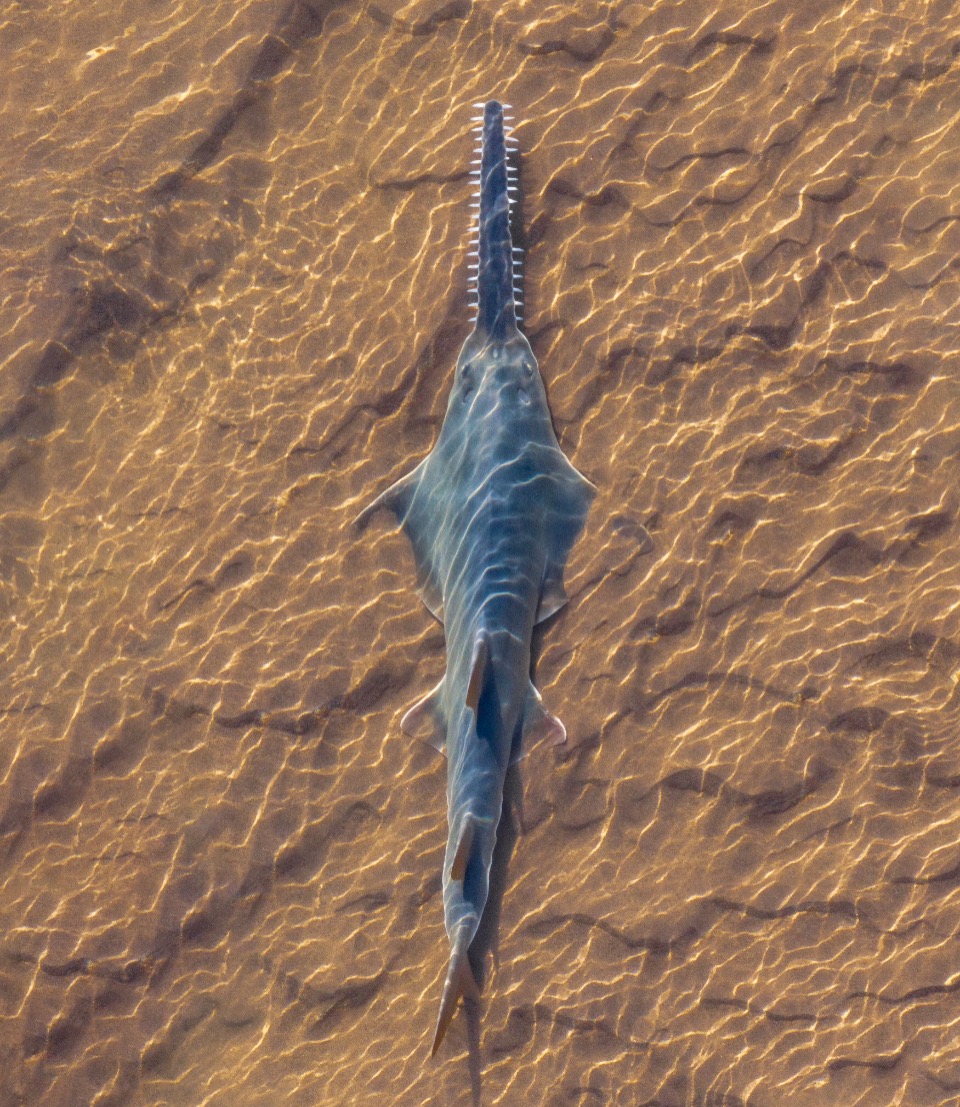
VANGUARD - Expressing the viewpoint of the Communist Party of Australia (Marxist-Leninist)
For National Independence and Socialism • www.cpaml.org
Photo credit: Alex Westover
Gina Rinehart should stop obsessing about destroying an unflattering portrait of herself by acclaimed Western Aranda artist Vincent Namatjira, and concentrate on how to stop destroying the Martuwarra Fitzroy River and the critically endangered freshwater sawfish!
Of seven sawfish species known to exist in the world, four are found in Western Australia. These species – the freshwater, dwarf, narrow and green sawfish – are mainly found in the Kimberley and Pilbara. The freshwater sawfish can grow to 7 metres in length and are thought to live to 30 years or more. Their relatively low rate of reproduction means that sawfish stocks are slow to recover if depleted.
The freshwater sawfish is listed as critically endangered by the International Union for Conservation of Nature (IUCN) and is totally protected from recreational and commercial fishing under WA State legislation. In addition, the freshwater sawfish is protected under Federal legislation.
Rinehart
Rinehart, Australia’s richest person with an estimated net worth in excess of A$37 billion, is a mining magnate with extensive pastoral properties.
She has a license to pump water from a tributary of the Martuwarra for her Liveringa Station, a 2,650 square kilometres property with a carrying capacity of over 22,000 head of cattle.
Last November, 17 critically endangered freshwater sawfish died in a dry creek on Liveringa Station. The news has only just been revealed. It is the second mass sawfish kill on the station. Forty sawfish died at the Kimberley pastoral station in December 2018.
Those deaths were initially covered up to protect Hancock. Documents obtained under freedom of information showcased internal government communication, with concerns about a "negative story" and a manager from a government department "trying to prevent the issue getting out to the media".
First Peoples and freshwater sawfish
The sawfish has cultural significance for First Peoples across northern Australia.
They are a traditional food source for Aboriginal people living along the Fitzroy River. The species features in stories and beliefs. Bunuba people call freshwater sawfish ‘galwanyi’, the Gooniyandi people call it ‘wirridanyniny’, the Nyikina, ‘pial pial’ and the Walmajarri people, ‘wirrdani’. A traditional way of catching sawfish and other species by the Nyikina and Walmajarri people is to put bark from a freshwater mangrove tree in a waterhole. This removes oxygen from the water, causing the fish to float and become easy to catch. It also makes it vulnerable to declining water quality caused by over-extraction for pastoral and other irrigation purposes.
In early 2017, Gurindji girl Lisa Smiler caught a 2.7metre sawfish in Wattie Creek near Kalkarindji, 800 kilometres south of Darwin. Gurindji elders were surprised that the fish had come so far south, but, known as "kunpulu" in the Gurindji language, it has been documented in the area in Indigenous rock art found on Revolver Creek, a tributary of the Victoria River, near Kalkarindji. The same word is used in languages along the Victoria River.
Manage water for the environment, not Rinehart’s profits
The Martuwarra/Fitzroy's massive catchment area spans 40 cattle stations, including Mrs Rinehart's Liveringa, Fossil Downs and Nerrima stations.
Hancock’s company reportedly wants to harvest 325 gigalitres of surface water when the river is in flood to "supercharge" the region's cattle industry.
To put that in perspective, Perth's total overall annual water use is 395GL, according to the WA Department of Water's Water for Growth report.
The Martuwarra’s flow is already impeded by Camballin Barrage, 150 kilometres upstream from the limit of tidal influence. It is thought to obstruct the upstream migration of juvenile freshwater sawfish during much of the year when the river level is below the height of the weir. Originally built to divert water for farming, the weir is now a fishing and tourism spot.
Discussions over the future of water extraction along the river must be separated from capitalist commercial considerations.
The mighty Martuwarra Fitzroy River is the last stronghold for the sawfish and its last great nursery – which is why protecting the river is crucial for its survival.
This latest fish kill is a sad reminder of why the surface flows of Martuwarra Fitzroy River must be left alone and not put at risk for large-scale development.
Last October, under pressure from campaigners for the Martuwarra, the WA Government announced a commitment for no further surface water take from the Martuwarra Fitzroy River. This is good, but not enough. The existing water take must be adjusted downwards as the two recent fish kills have occurred under its arrangements.
Local campaigners are determined to stop the Martuwarra becoming another Murray-Darling disaster.